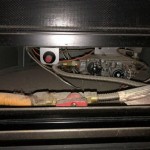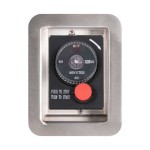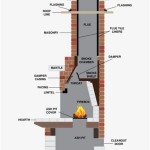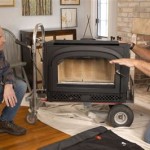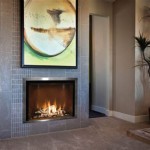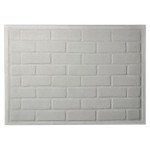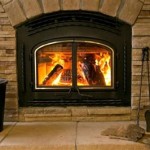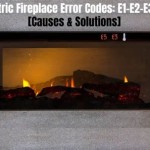Fireplace Portable Heaters: A Comprehensive Overview
Fireplace portable heaters represent a growing segment of the home heating appliance market. These devices aim to replicate the aesthetic appeal of traditional fireplaces while offering the convenience and efficiency of portable electric heaters. This article will explore the features, benefits, types, safety considerations, and factors to consider when selecting a fireplace portable heater.
Understanding the Appeal: Aesthetics and Functionality
The primary driver behind the popularity of fireplace portable heaters is their ability to combine visual appeal with practical heating capabilities. Unlike traditional electric heaters, which often prioritize functionality over aesthetics, these units incorporate visual elements that mimic the appearance of a real fireplace. This feature contributes to a sense of warmth and ambiance in a room, making them a desirable heating solution for living rooms, bedrooms, and other spaces where aesthetics are valued.
The simulated flames are typically created using LED lighting and reflective surfaces. The technology varies between models, with some offering more realistic flame effects than others. Some models include adjustable flame brightness and speed settings, allowing users to customize the visual experience to their preferences. These settings can be adjusted independently of the heating function, allowing users to enjoy the ambiance of a fireplace even when supplemental heat is not required.
In terms of functionality, fireplace portable heaters operate on the principle of electric resistance heating. An electrical current is passed through a heating element, typically made of metal coils or ceramic plates. The resistance of the element to the current causes it to heat up, and a fan then circulates the heated air into the room. This method of heating is efficient for small to medium-sized spaces, and it allows for precise temperature control.
Many fireplace portable heaters include a thermostat that allows users to set a desired temperature. Once the room reaches the set temperature, the heater will automatically cycle on and off to maintain a consistent level of warmth. This feature helps to conserve energy and prevent overheating.
The portability of these heaters is another key advantage. They are typically lightweight and equipped with wheels or handles, making them easy to move from room to room. This allows users to focus heating efforts on the areas where they are currently spending time, further enhancing energy efficiency.
Types of Fireplace Portable Heaters
Fireplace portable heaters can be categorized based on their heating technology, design, and features. The two primary heating technologies used in these heaters are electric resistance coils and infrared heating.
Electric Resistance Coil Heaters: These are the most common type of fireplace portable heater. They use metal coils as the heating element. When electricity passes through the coils, they heat up and a fan blows the heated air into the room. Resistance coil heaters are generally less expensive than infrared heaters, but they may not be as energy efficient.
Infrared Heaters: Infrared heaters use quartz or ceramic heating elements to generate infrared radiation. This radiation directly heats objects and people in the room, rather than heating the air. Infrared heaters are often more energy efficient than resistance coil heaters because they focus heat on specific areas. They also tend to provide a more even heating effect, as they do not rely on circulating hot air.
Design Variations: The design of fireplace portable heaters varies widely. Some models are designed to resemble traditional wood-burning fireplaces, complete with a simulated firebox and mantel. Others have a more modern and minimalist aesthetic. Some units are freestanding, while others are designed to be placed against a wall.
Features: Beyond the basic heating and flame simulation functions, fireplace portable heaters may include a variety of additional features. These features can enhance the functionality, convenience, and safety of the heater. Common features include:
- Adjustable Thermostat: Allows users to set a desired temperature and maintain a consistent level of warmth.
- Multiple Heat Settings: Provides options for low, medium, and high heat output, allowing users to customize the heating level to their needs.
- Timer: Allows users to set the heater to automatically turn on or off at a specific time.
- Remote Control: Provides convenient control over the heater's settings from a distance.
- Overheat Protection: Automatically shuts off the heater if it overheats, preventing damage and reducing the risk of fire.
- Tip-Over Protection: Automatically shuts off the heater if it is accidentally knocked over, preventing a fire hazard.
- Cool-Touch Housing: Ensures that the exterior of the heater remains cool to the touch, even when it is operating at high heat settings, reducing the risk of burns.
Safety Considerations and Proper Usage
While fireplace portable heaters offer convenience and aesthetic appeal, it is crucial to prioritize safety when using these devices. Like any electrical appliance that generates heat, improper usage can pose fire hazards and safety risks.
Placement: The placement of the heater is critical for safety. The heater should be placed on a level, stable surface away from flammable materials such as curtains, furniture, and paper. A minimum clearance of three feet should be maintained around the heater to ensure adequate ventilation and prevent overheating. The heater should not be placed in areas where it could be exposed to water or moisture, such as bathrooms or near sinks.
Electrical Safety: Fireplace portable heaters should be plugged directly into a wall outlet. Using extension cords or power strips can overload the circuit and increase the risk of fire. It is essential to ensure that the outlet is properly grounded and that the electrical circuit is capable of handling the heater's power requirements. Regularly inspect the power cord for damage, and replace the cord if any damage is found. Never operate a heater with a damaged power cord.
Supervision: Fireplace portable heaters should not be left unattended, especially when children or pets are present. Children and pets may be curious about the heater and could accidentally touch the hot surfaces or knock the heater over. It is important to supervise children and pets closely when the heater is in use.
Maintenance: Regular maintenance is essential for ensuring the safe and efficient operation of a fireplace portable heater. The heater should be cleaned regularly to remove dust and debris that can accumulate on the heating element and fan. Use a soft, dry cloth to clean the exterior of the heater. Never use water or other liquids to clean the heater. Check the air vents regularly to ensure that they are not blocked. A blocked vent can cause the heater to overheat.
Overheat Protection and Other Safety Features: Always ensure that the heater is equipped with safety features such as overheat protection and tip-over protection. These features can help to prevent accidents and reduce the risk of fire. Test the safety features periodically to ensure that they are functioning correctly.
Proper Ventilation: Adequate ventilation is essential when using any type of space heater. While fireplace portable heaters do not produce carbon monoxide like combustion-based heaters (gas or wood burning), they still consume oxygen and can cause the air in a room to become dry. Ensure proper ventilation by opening a window or door slightly to allow fresh air to circulate. This is especially important in small, enclosed spaces.
By following these safety guidelines, users can enjoy the warmth and ambiance of a fireplace portable heater while minimizing the risk of accidents and hazards.
Factors to Consider When Selecting a Fireplace Portable Heater
Choosing the right fireplace portable heater requires careful consideration of several factors, including the size of the room, heating needs, desired features, and budget. A thorough evaluation of these factors will help to ensure that the selected heater meets the user's specific requirements.
Room Size and Heating Capacity: The size of the room to be heated is a primary factor in determining the appropriate heating capacity. Heaters are typically rated in terms of wattage or BTU (British Thermal Units). A higher wattage or BTU rating indicates a greater heating capacity. A general guideline is to select a heater with approximately 10 watts of power per square foot of room space. For example, a 150 square foot room would require a heater with a capacity of approximately 1500 watts. However, it is important to consider other factors such as insulation, window size, and ceiling height, which can affect the heating requirements.
Heating Technology: As previously mentioned, fireplace portable heaters utilize either electric resistance coils or infrared heating technology. Each technology has its own advantages and disadvantages. Resistance coil heaters are generally less expensive, but they may not be as energy efficient. Infrared heaters are more energy efficient and provide a more even heating effect, but they tend to be more expensive. The choice between the two technologies will depend on the user's budget and heating priorities.
Features: The desired features will also influence the selection of a fireplace portable heater. Consider features such as adjustable thermostat, multiple heat settings, timer, remote control, overheat protection, tip-over protection, and cool-touch housing. Evaluate which features are most important based on the user's lifestyle and safety concerns.
Design and Aesthetics: The design and aesthetics of the heater should complement the décor of the room in which it will be used. Consider the overall style of the room and select a heater that blends in seamlessly. Fireplace portable heaters are available in a wide variety of styles, from traditional to modern, so there is likely to be a model that suits the user's taste.
Energy Efficiency: Energy efficiency is an important consideration, especially for users who plan to use the heater frequently. Look for heaters with energy-saving features such as adjustable thermostat and multiple heat settings. Infrared heaters are generally more energy efficient than resistance coil heaters.
Safety Certifications: Before purchasing a fireplace portable heater, ensure that it has been tested and certified by a reputable safety organization such as UL (Underwriters Laboratories) or ETL (Electrical Testing Laboratories). Safety certifications indicate that the heater has been tested to meet safety standards and that it is safe to use.
Budget: The budget is always a key consideration when selecting any appliance. Fireplace portable heaters range in price from relatively inexpensive to quite expensive. Determine a budget beforehand and then look for a heater that meets the user's needs and preferences within that budget. Keep in mind that more expensive heaters may offer better performance, features, and longevity.
By carefully considering these factors, prospective buyers can make an informed decision and select a fireplace portable heater that provides both warmth and aesthetic appeal while ensuring safety and energy efficiency.

Lifeplus Electric Fireplace Heater Freestanding Stove With 3d Realistic Flame For Indoor Home Safe Use 750w 1500w 17 Com

1400w Electric Fireplace Heater 14 Freestanding Stove Portable Space With Fake Flame Overheat Protection For Indoor Use Small Com

Comfort Zone 1 500 Watt Black Electric Fireplace Stove Heater With Realistic 3d Flame Effect Czfp4 The Home Depot

8 Best Electric Fireplace Heaters In 2024 Infrared Fireplaces

Homcom Electric Heater Safe Fireplace Freestanding W Artificial Flame Effect Diy At B Q

Cambridge Freestanding Electric Fireplace Heater With Log Display Black 1 Ct Fred Meyer

A Portable Electric Fireplace And More Clever Items To Simplify Your Life In 2024

Costway 14 Portable Electric Fireplace Heater Mini Freestanding Infrared Stove Target

Stylewell Kingham 400 Sq Ft Panoramic Infrared Electric Stove In Black With Electronic Thermostat Est 417 10 The Home Depot

18 Inch Electric Fireplace Insert Freestanding And Recessed Heater Flame Remote

